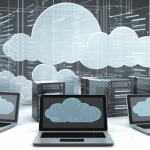Why UI/UX is significant for SaaS development in 2023

UI/UX design is crucial for SaaS products because it directly impacts the user's experience with digital technology. Today's users demand a seamless and intuitive experience when using any software or application. A confusing or cluttered user interface (UI) can quickly turn users away, causing them to search for alternative options. On the other hand, a well-designed UI/UX can make all the difference in whether a user decides to continue using a SaaS product or switch to a competitor.
Good UI/UX design can also improve the overall functionality and efficiency of a SaaS product, leveraging the power of digital technology to increase productivity and satisfaction among users, create a positive brand perception, and reduce support costs, improving customer retention. To remain competitive in the age of digital technology, SaaS companies need to prioritize UI/UX design as an ongoing process to ensure that the interface meets the changing needs of users and the industry.
Could advances in technology help banks increase their ESG potential?

Big banks once had almost unmatched dominance over the global financial sector. It allowed them to build glittering skyscrapers as their headquarters and helped transform London’s Canary Wharf from disused docks into what is probably Europe’s preeminent financial hub. In recent years, however, that dominance has come under threat from challenger and neo-banks, as well as from innovative fintech startups.
In fact, research released in 2022 shows that as many as 44 percent of UK business banking customers have already switched from a traditional bank to an online one. Almost two-thirds (65 percent) made the switch because they thought the online bank offered a better product. At the same time, the collapse of Silicon Valley Bank and the forced takeover of Credit Suisse by UBS has players across the sector scrabbling to avoid a global banking crisis.
Five ways to build sustainability into your existing IT strategy

This year, World Earth Day is challenging organizations and consumers alike to make more sustainable choices and Invest in Our Planet. With sustainability increasingly becoming a boardroom priority, IT buyers are playing a vital role in leading this investment into creating more sustainable business practices.
Intelligent technologies such as IoT and machine learning are a popular example of this. From smart light switches and thermostats to route optimization software, these investments help organizations to reduce their wasted resources and function more sustainably on a day-to-day basis.
Why talent is key for businesses who want to harness the power of data

For decades, businesses have been using data for growth. Today, the importance of utilizing data to gain insights into customer behavior, market trends and business performance continues to develop. However, harnessing the power of data requires more than just the right tools and technology -- it also requires the right talent.
Technological developments, such as artificial intelligence (AI) and the Internet of Things (IoT), have resulted in data and data analysis providing increasing opportunities for businesses to improve their competitive edge. Data is a valuable resource in all sectors, but it is only useful if it is analyzed, interpreted and applied correctly -- this is where talented individuals with an understanding of data science and analytics come in.
Why Hybrid Cloud is here to stay

Cloud has completely changed how contemporary businesses operate. It gives organizations a scalable means of managing their infrastructure, applications, and data. Between its flexibility and Pay as You Go (PAYG) options, Cloud provides substantially more configuration and design options than traditional infrastructure. As a result, businesses are adopting cloud services more and more frequently, giving them access to new tools and technologies, while also yielding efficiency improvements for their operations and procedures.
According to some projections, the worldwide cloud services industry will be worth about $600 billion by 2023, generating a rapidly expanding need for hybrid and multi-cloud solutions. Gartner expects that cloud system infrastructure services will be the second-biggest, but fastest-growing, cloud expenditure market category in 2023. As illustrated by the projected increase, hybrid and multi-cloud computing is becoming the new normal for many organizations -- providing them with the scalability benefits of public cloud -- while also delivering the flexibility and control inherent in private cloud computing and traditional server infrastructure.
As device fingerprinting becomes more challenging new risk signals emerge

At Incognia, we speak with experts in the fields of risk, trust & safety, security, and data science every day, and in almost every one of these conversations, one or all of these recurring themes are mentioned:
1) Fraudsters and scammers are innovating at an accelerated pace, 2) Fraud detection technologies that were once extremely reliable have become less effective, specifically device fingerprinting, 3) Evaluating new risk signals is critical in an effort to continuously stay ahead of the fraudsters and scammers.
Why agentless security is not real security

Many security professionals have been misled into believing in the overhyped promise of agentless security. But it looks like the long-lasting 'agentless vs. agent' debate is finally over and the result is finally in -- if you want great cloud workload security, you need an agent.
This noteworthy outcome arose when two of the leading agentless-only vendors finally gave in and announced partnerships with agent-based runtime security and CWPP (cloud workload protection platform) vendors. This is big news, because both of these companies had previously, and persistently proclaimed, that agents are 'old school' and that 'agent-based security is dead'.
The persistent accountant shortage sees firms struggling and SMBs turning to software as a savior

Within the last two years, droves of accountants and auditors across the U.S. have exited the financial field, severely limiting the services and expertise that accounting firms provide many small and midsize businesses (SMBs).
Unfortunately, America’s accountant shortage shows no signs of stopping, and many SMBs continue to face significant challenges when partnering with outside accounting firms. In fact, according to Capterra's Accounting Shortage Survey, 64 percent of SMBs are struggling to find outside firms that can handle their accounting and finance needs.
Databases on Kubernetes -- Support your cloud native strategy with open source Kubernetes operators

Today, developers are used to running applications in the cloud. They are accustomed to using software containers and building applications using microservices components connected by APIs. Gartner estimates that more than 90 percent of global organizations will be running containerized applications in production by 2027, up from less than 40 percent in 2021. Similarly, the company has predicted that 70 percent of organizations will complement continuous delivery for their applications with continuous infrastructure automation to improve business agility by 2025.
From an infrastructure perspective, this means Kubernetes. However, Kubernetes was initially built to manage stateless application components rather than the rest of the infrastructure that goes to make up IT systems. For the other elements involved, such as databases, containerization had to be made to fit.
Creating a cybersecurity risk assessment

Most businesses will complete regular risk assessments as standard practice. They’re crucial to reducing the threat of financial or reputational loss and give you an overview of the high-risk areas you must address.
One type of risk analysis that is critical but sometimes overlooked is a cybersecurity risk assessment. In today’s digital-first world, it’s difficult to overstate the importance of analyzing and addressing threats to your IT security. Making it a regular occurrence is also advised because cybercriminals are finding new holes in your defenses every day.
To address these threats, full and frequent cybersecurity audits are necessary to review:
The most important factors in modern enterprise backup

Technology and the data that powers it are continually evolving. This is particularly true with enterprise organizations, which are more focused than ever on protecting and securing their data across increasingly complex IT environments. Against this backdrop, what do enterprises need to focus on?
Firstly, a Modern Data Protection strategy and the deployed backup solution supporting it must be able to protect workloads across any IT environment. The rise of cloud migration and affiliated services has meant that the physical data center is no longer the heart of the IT infrastructure. The Veeam Data Protection Trends Report 2023 found that the average breakdown of servers is 28 percent in physical servers within a data center, 25 percent on virtual machines (VMs) hosted within the data center and 47 percent on VMs hosted within a hyperscaler or Managed Service Provider (MSP). This means that the modern environment is heavily dispersed, highly virtualized and mostly cloud-hosted.
From a hacker's cheat sheet to malware… to bio weapons? ChatGPT is easily abused, and that's a big problem

There's probably no one who hasn't heard of ChatGPT, an AI-powered chatbot that can generate human-like responses to text prompts. While it's not without its flaws, ChatGPT is scarily good at being a jack-of-all-trades: it can write software, a film script and everything in between. ChatGPT was built on top of GPT-3.5, OpenAI’s large language model, which was the most advanced at the time of the chatbot's release last November.
Fast forward to March, and OpenAI unveiled GPT-4, an upgrade to GPT-3.5. The new language model is larger and more versatile than its predecessor. Although its capabilities have yet to be fully explored, it is already showing great promise. For example, GPT-4 can suggest new compounds, potentially aiding drug discovery, and create a working website from just a notebook sketch.
Defense in the cloud: Embracing technology for a competitive edge

The UK Defense sector is poised for a significant shift towards cloud services in 2023, aimed at unlocking the potential of data and attracting top talent to drive the initiative.
Over the past few years, the Ministry of Defense (MoD) has made great strides in cloud adoption through its MODCloud program, resulting in cost savings and improved data accessibility and security. However, the true value lies in the 24/7 cloud services on offer. The recently published Cloud Strategic Roadmap for Defense sets out the ambition.
The value of a partner in bridging the gap between organizational IT strategy, implementation, and management

The most important aspect of identifying an IT strategy is gaining an understanding of common strategic goals across the organization while simultaneously keeping the participating business units top of mind. When bridging the gap between organizational IT strategy, implementation and management efforts, legacy IT applications will undoubtedly be impacted. Because of this, there must be a vital analysis of the "AS-IS" state and the "TO-BE" state to ensure comprehension from a technology and process perspective. By engaging stakeholders, organizations can ensure that necessary resource allocations have been made to meet strategic IT goals. This type of tactical partnership helps keep the company's vision at the forefront, even amid a complex and large-scale digital transformation.
Once the implementation stage begins, the deployed technologies should seamlessly align with the organization’s top business objectives. Whether strategic goals fall under the tier of scalability, performance or customer experience, the proper partner can help to identify and achieve business-driven results. The organization also needs to ensure all siloed legacy applications are factored in and shifted into the "TO-BE" state along with any data migration viewpoints. This means that movement strategy must be defined as being big-bank or incremental implementation from application delivery all the way to data migration.
How to avoid phishing scams as we approach this year's tax deadline

U.S. taxpayers beware! Tax scams and malware attacks are running rampant as we approach this year's tax deadline -- mostly driven by phishing scams.
With the looming April 18 US tax deadline, cybercriminals have sprung into action. For one, a devious Emotet malware phishing campaign has been launched, masquerading as official W-9 tax form emails sent from the Internal Revenue Service (IRS) and companies that may be connected to your work life. A malicious group known as Tactical#Octopus is also on the prowl and looking to spread malware through fake file downloads claiming to be related to taxes.
BetaNews, your source for breaking tech news, reviews, and in-depth reporting since 1998.
© 1998-2025 BetaNews, Inc. All Rights Reserved. About Us - Privacy Policy - Cookie Policy - Sitemap.
